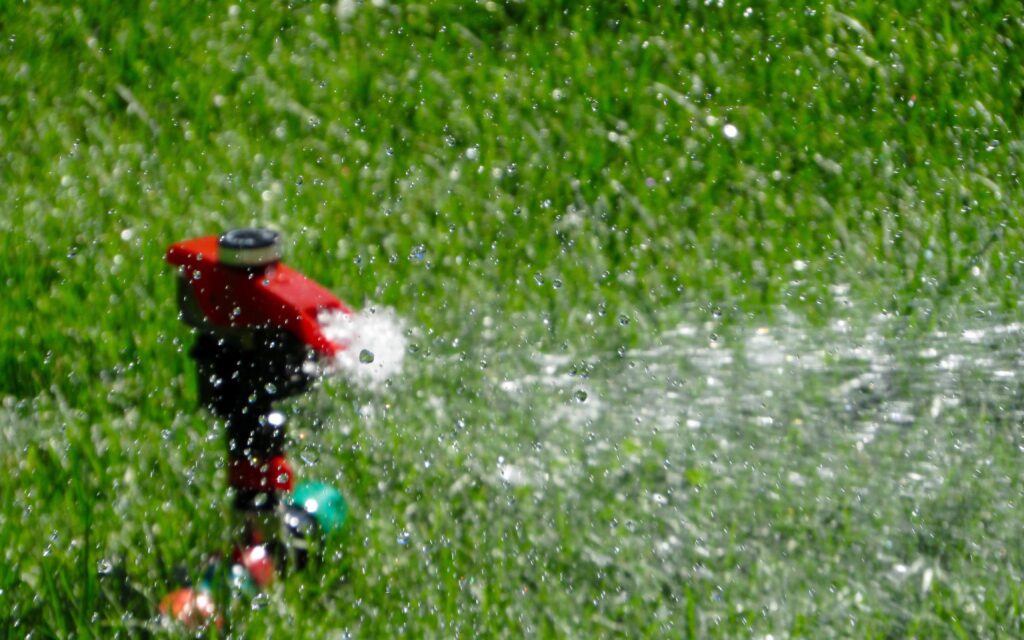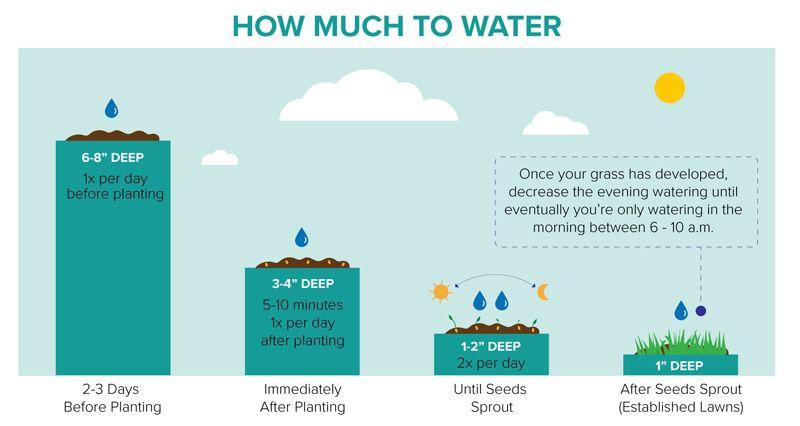Thing You Need to Know About Watering New Grass Seed
So, once you’ve put your money, time, and energy into planting new grass seeds, what’s next? It’s self-evident that you need to begin watering them. Thus, in this article I will about watering new grass seed.
As you’ll see, watering new grass seed may require the same amount of effort as planting them. As a result, your ideal dreamy lawn will probably realize.
You probably already know this, but nothing nice comes on a silver platter. It’s no different when it comes to watering new grass seeds.
Thus, what’s the best way to go about it? In your efforts to transform your to-be lawn into the gorgeous green grass you’ve always desired, a proper watering plan may come in helpful. But, first and foremost, let’s get this over with.

When To Plant Your Grass Seed?
The time of year you put grass seed has a direct influence on its performance. When your grass seed is sown at the right time, it will germinate effectively, grow rapidly, and remain healthy as it grows.
The best time to plant grass seed varies by where you live and what kind of grass you have. Cool-season grasses comprising Kentucky bluegrass, tall fescue, and perennial ryegrass are often found in lawns throughout the northern United States.
When the temperature is colder, planting in the fall and spring coincides with these grasses’ most active growth seasons.
The second-best approach is to plant cool-season grasses in the spring. Seeding should be done early this season when the temperature is between 60 and 75 degrees Fahrenheit throughout the day.
It closely correlates to the ideal soil temperatures for germination of cool-season grass seed. Both spring sunlight and rain help grass grow strong.
Southern parts of the United States typically have warm-season lawn grasses such as Bermudagrass, Zoysia grass, Bahiagrass, and Centipede grass.
Planting these grasses at their peak growing season in the spring and early summer rather than the fall is the best option. Plant warm-season grasses only when daytime temperatures are approaching 70°F.
Water Before Seeding
When your dirt is moist, plant your seeds. It kick-starts the seeds and signals to them that it’s time to start developing.
If you distribute your seeds on dry soil, they will be exposed to birds, the wind, or just becoming dormant. Furthermore, roots may travel more easily through damp soil than dry soil, which might be harder or more compact.
Before you plan to seed your grass, soak it well for several days. Wet the top six inches of your soil, loosen the soil and provide a steady water flow to the arriving grass seeds.
When seeds are planted in moist, loose soil, they should germinate very immediately.
It is not difficult to grow lush, thick grass from seed. Any spot of barren ground may become part of a lovely yard if you follow my advice.
Nothing is stopping you from planting the lawn of your dreams, whether it’s for environmental reasons or just for the sake of aesthetics!
How Often Do You Need to Water New Grass Seed?
Many people ask the question, how long to water grass seed? The answer is, before you put the seeds, give the earth a good soaking. A good quantity of water for the soil a few days before planting is 6 to 8 inches.
The goal of fresh grass seed is to keep the soil wet. The fresh seeds will suffocate by waterlogged soil. Water new grass seeds twice or three times a day for 5 to 10 minutes each time. In this manner, any water that has to evaporate is replaced without oversaturation. 3-4 inches of water each week is the average.
Once the grass seeds have germinated, you should water them once a day for a longer length of time. Watering should gradually be reduced to a long soak of around 40 minutes on alternate days, then 2-3 days per week.
Watering following germination is done to help the grass grow deeper roots. It needs less regular watering. Keep a close eye on the weather.
Showers and heavy rain will indicate how frequently you should water grass seed. After the rain, skip the watering session.
It’s unlikely that you’ll want to get up early on a Saturday morning only to water your grass. To automate this operation, install a high-quality sprinkler system with a timer. This will be the best time to water grass seed.
How Much To Water New Grass Seed?
How often to water new grass seedlings is a common question asked by many beginner gardeners. Grass seed watering is both easy and difficult, according to the best recommendations. You only get one chance to germinate seedlings properly.
- Insufficient water will kill the sprout.
- Too much water will provide less-than-ideal outcomes.
Before they may germinate, all seeds require moisture and a specific temperature range. If circumstances change after the germination process has begun, the seed or new sprout is susceptible and may perish. When a seed or sprout dries up, it dies. Your goal is to keep the environment wet at all times.
The period before you see any sprouts is the most important. You must maintain your commitment to watering new grass seed. Grass seed might take anywhere from 5 to 30 days to germinate, depending on the type. In colder conditions, it might take much longer. It is the amount of time it will take to see the grass grow.

The seed, or the soil and mulch in touch with the seed, must remain wet until this stage. It doesn’t have to be dripping wet or swimming, but it should be damp.
The roots of the new grass grow down into the earth after the new grass is apparent. It occurs pretty rapidly.
The plant is less susceptible now that soil moisture below ground is more available to the roots. However, don’t cut back on watering fresh grass seeds just yet.
Seeds will be buried at various depths, absorb water in different ways, and be of varying quality and maturity.
Many seed mixes are blends of many kinds, each with its own set of traits that will influence how they develop. It’s critical to maintain the surface area wet until all of the seeds have germinated.
Allow the planted area to dry out until it covers with green growth. You have complete control over the percentage of seeds that germinate!
How Long Can Grass Seed Be Without Water?
At the time of germination, the grass is vulnerable. To take root and begin taking in nutrients, the tiny root tendrils that emerge from the seed require wet soil.
If the seed germinates in dry soil, it cannot establish a root and will perish. As a result, it’s critical to keep the soil wet at all times until the grass sprouts.
Depending on the grass seed you’ve distributed, you may need to follow this watering regimen for a few days to many weeks.
Ryegrass can sprout in as little as five days, although Bermuda and Kentucky Bluegrass types might take up to 30 days to germinate.
After the seeds sprout, adjust the watering schedule
Congratulations, depending on the germination time, you should have fresh grass seeds sprouting in approximately 14 days.
The new grass sprouts are grown from seedlings to grass, which needs more watering to build a healthy root system.
You will aim to keep the soil moist while avoiding flooding the area with excessive volumes of water. You may maintain the soil moist two to three inches deep using your selected watering system to allow the roots to develop and avoid excessive evaporation.
You’ll want to adjust your watering plan now that the seeds have germinated. Now you’ll do the following:
- Sprinklers should be run daily for 45 to 60 minutes.
- This is something you’ll do around 2-3 times a week.
- If you live in a hot climate, you may need to water more frequently each week.
You aim to irrigate one inch to an inch and a half of soil every week, divided into two or three waterings.
After the seeds germinate and your yard begins to transform into the lush lawn of your dreams, reduce nighttime watering and just water in the mornings to keep the soil moist to one inch deep.
Remember that the length of time it takes for your fresh grass seed to germinate is determined by the type of grass and the weather conditions in your area. You may water it less regularly once it’s established, which will help the grassroots to spread throughout the soil.
Your grass will grow and flourish throughout the spring, summer, and fall seasons if you water in the morning and keep a weekly watering of approximately one inch.
How Long Until My New Grass Grows?
The germination process refers to the time it takes for grass seed to grow in your lawn after being planted. Obtaining a lush green covering will take some time.
The average period for grass seed to germinate is 5 to 30 days. Several factors must be taken into account, including the weather and the type of grass seed.
Keep in mind that not all seeds grow at the same time. You could have a combination of seed types with distinct growth properties in some situations. You should know how these seeds will act in your yard before you plant them.
As you can see, the germination period varies depending on the grass type. In general, grass seeds will develop by specific germination periods, such as:
- Between 10 and 14 days for bentgrass
- 10 to 30 days for Bermuda grass
- 14 to 30 days for buffalo grass
- Between 14 and 21 days for centipede grass
- 7 to 14 days for fescue
- 14 to 30 days for Kentucky bluegrass
- 7 to 10 days for rough bluegrass
Conclusion
It’s a delicate balancing act to watering new grass seed. To maintain a beautiful lawn, you must keep your soil moist before germination, during the growing phase, and after that.
It’s essential to keep the grass wet but not soggy. It would be best if you also remembered that grass takes a year to develop, so you’ll need to water even after your seeds have grown o the grass.







